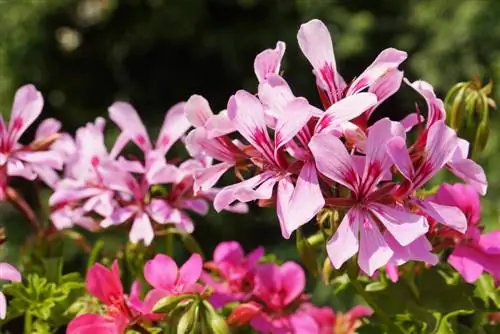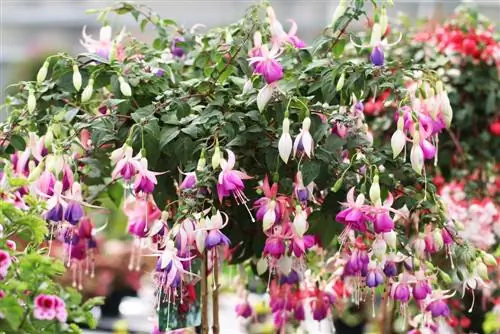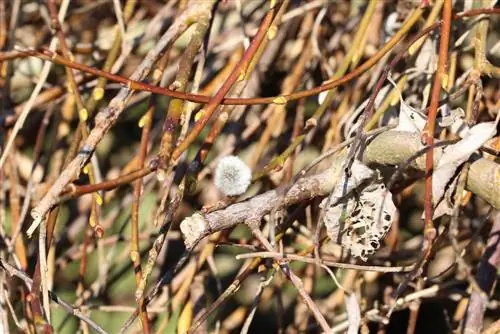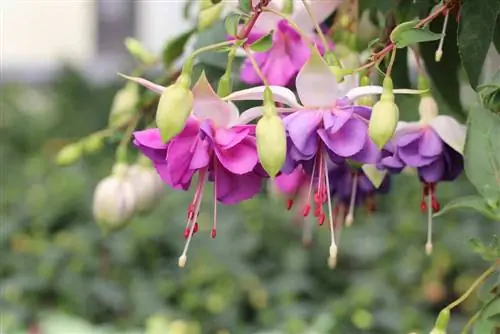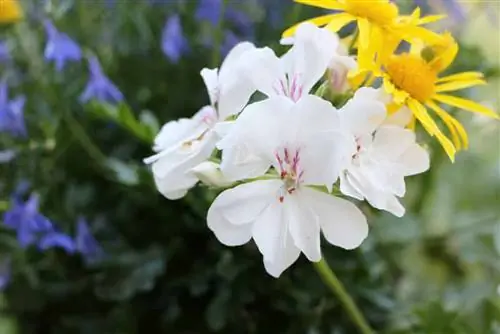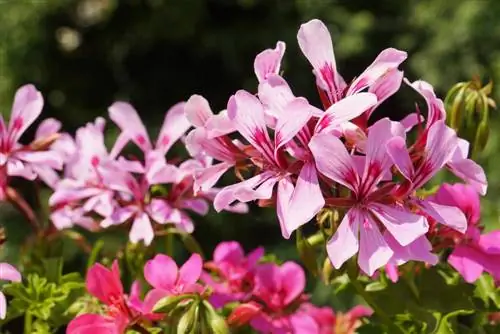- Author admin [email protected].
- Public 2023-12-17 03:39.
- Last modified 2025-06-01 06:48.
Pelargoniums, commonly known as geraniums, are very popular plants that are often found in gardens and on balconies. They are easy to care for and delight with a long, intensive flowering period. The colors red, pink, white and purple are most common.
There are a variety of species, with the upright and hanging pelargoniums being the best known to hobby gardeners. If you want to enjoy the plants for several years, you can overwinter them.
Annual Plan
- Spring: end hibernation
- Summer: care, water, fertilize regularly
- Autumn: initiate hibernation
- Winter: little need for action, check for rot every now and then
Overwintering pelargoniums in the cellar
When the pelargoniums have bloomed in autumn, they are cut back to about half before the first frost. Any remaining flowers, leaves or buds should be removed. A room that is as dark and cool as possible but frost-free is well suited for wintering, usually this will be a cellar or garage. The plants are watered sparingly so that they do not dry out completely. They are not fertilized in winter, but should be checked from time to time for mold formation.
If you have little space available, you can also remove the plants from the boxes, shake off the soil and store several plants together in one pot. It is sometimes recommended to overwinter the pelargoniums hanging upside down, with the root balls enclosed in a bag.
Alternative - overwintering on the windowsill
The pelargoniums can overwinter on the windowsill even in a room with the lowest possible temperature. The plant is also shortened, watering is greatly reduced and fertilization is stopped over the winter. However, buds continue to form, which must be removed again and again until spring so that the plants are not weakened.
Overwintering pelargonium cuttings
Another very popular and space-saving overwintering method is to cut off shoot ends that are approx. 15 cm long from autumn onwards. The lower leaves as well as buds and flowers must be removed so that the plant can concentrate on root formation. The Pelargonium cuttings are then placed about 2 cm deep in containers with potting soil, kept slightly moist and covered with glasses or plastic bags. Waterlogging must be avoided at all costs. A bright location without direct sunlight is important for optimal growth.
Care after wintering
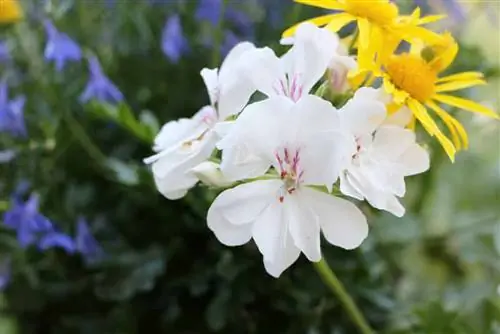
In spring the pelargoniums are taken out of their winter quarters and shortened again. Wilted plant parts must be removed and the plants repotted. They are given a bright, warmer location, but direct sunlight should be avoided. Watering should now be done regularly. If the outside temperatures are appropriate, the pelargoniums can go outside again, although it should be noted that there can still be night frosts until May. Fertilizing, ideally a weekly application with a liquid fertilizer, is now becoming more important again. The plants become strong and less susceptible to pests. The location can be quiet sunny. Old leaves and flowers must be removed regularly, especially after heavy rain, to avoid creating a basis for disease.
Diseases and pests
The actually quite robust pelargoniums are rarely attacked by diseases and pests if they are watered correctly and not planted too closely. If the growth is too dense, mold formation or infestation with aphids or spider mites is possible. A large proportion of pests can be controlled with a lye mixture of water and dishwashing liquid, but this should not get into the soil. In more stubborn cases, pest control products from specialist retailers must be used. Diseases that occasionally occur due to improper care, pelargonium rust and gray rot, occur particularly when the leaves are too wet. When watering, you should only moisten the soil and not the plant.
Hobby gardeners who give their pelargoniums some time and care and implement the tips for overwintering can enjoy their plants for many years. These are a real eye-catcher in the garden or on the balcony.
Conclusion about overwintering standing and hanging pelargoniums
Standing and hanging geraniums can be overwintered without any problems. The right time here would be late autumn, when almost all of the plant's inflorescences have bloomed and the plant loses its first leaves. As soon as the first frosts set in, the pelargoniums should be moved to their winter home.
- First cut the pelargoniums - whether standing or hanging - back by a third. The ideal size for overwintering would be around 20 centimeters. Shorten so that flowers or leaves that are still green are removed.
- Take the plants out of the pots or flower boxes and remove the soil from the root balls. The small branches can still be covered with some soil.
- Store the pelargoniums in a cool but frost-free room. Garages or basements are ideal here.
- The plants should no longer be exposed to direct sunlight, otherwise they will start to sprout new growth early. However, since the plants are not watered during the winter, this would ultimately lead to the new shoots drying out and they would simply wither.
- Even if the pelargoniums are not watered during the winter break, their roots must not dry out under any circumstances. You can avoid this by packing the roots in a plastic bag. However, do not tie them too tightly, as some air should still be able to circulate.
- Hang the plants in the planter and don't pay much attention to the plants. Then the hanging and standing pelargoniums can recover sufficiently and gather new strength for flowering in the coming year.
- After the winter rest, you can put the plants back in your flower boxes or pots as usual, water and fertilize regularly.

